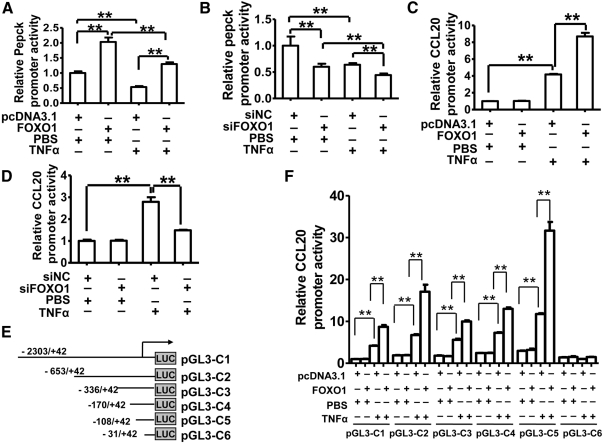Fig. 3.
FOXO1 stimulates promoter activities of PEPCK and CCL20. A, FOXO1 stimulates promoter activity of its known target gene PEPCK in HepG2 cells. A 593-bp (−523/+70) DNA fragment harboring the human PEPCK promoter was cloned into pGL3-Basic vector and used for luciferase assays 24 h after cotransfection with either a plasmid expressing constitutively active FOXO1-AAA or the control plasmid pcDNA3.1 with TNF-α (10 ng/ml) or PBS treatment for 24 h. B, Silencing of FOXO1 suppresses human PEPCK promoter activity in HepG2 cells. The PEPCK promoter construct was cotransfected with FOXO1 siRNA (siFOXO1) or a scrambled siRNA (siNC) into HepG2 cells, and luciferase activities were assayed 48 h after transfection with or without TNF-α treatment for 24 h. C, FOXO1 stimulates CCL20 promoter activity in TNF-α-treated HepG2 cells. A 2345-bp (−2303/+42) DNA fragment harboring the human CCL20 promoter was cloned into the pGL3-basic (pGL3–C1) vector. The construct was transfected alone (Control) or cotransfected with either FOXO1-AAA plasmid or pcDNA3.1. Cells were treated 6 h after transfection with TNF-α (10 ng/ml) for an additional 24 h and then harvested for luciferase assays. D, FOXO1 silencing decreases CCL20 promoter activity in TNF-α-treated HepG2 cells. Cells were transfected with FOXO1 siRNA (siFOXO1) or control siRNA (siNC) for 24 h, and then treated with TNF-α (10 ng/ml) for 24 h before harvesting for assays. E, A schematic depiction of different human CCL20 promoter regions cloned into the pGL3-basic plasmid. The constructs were designated as pGL3–C1-C6. F, Effects of FOXO1 overexpression on promoter activities of different CCL20 promoter constructs. HepG2 cells were cotransfected with FOXO1-AAA plasmid or pcDNA3.1 and each of the truncated promoter constructs. Cells were treated 6 h later with TNF-α (10 ng/ml) for an additional 24 h and then harvested for assays. Results are expressed as the relative luciferase activity normalized by the activity from the pcDNA3.1 and pGL3–C1 cotransfected group without TNF-α treatment (the first bar), which are arbitrarily defined as 1. Each of the experiments was repeated at least three times, and similar results were obtained. **, P < 0.001 vs. control.

